在世界范围内,多数斑岩Cu (-Mo-Au) 矿床均产在活动大陆边缘,并被解释为与洋壳的俯冲作用有关(Sillitoe, 1972; Mitchell, 1973; Sillitoe and Perella, 2005)。在中国,许多斑岩型矿床并不形成于洋壳的俯冲过程中,在时空上与大陆碰撞作用紧密相关,因此被认为是大陆碰撞体制的成矿作用(陈衍景和富士谷,1992;陈衍景,2006;Chen et al., 2007)。大陆碰撞成矿理论引起了学者们的关注,最近十年,在我国喜马拉雅造山带、秦岭-大别造山带以及中亚造山带的斑岩矿床相继被解释为大陆碰撞成矿的产物(侯增谦等,2007;李诺等, 2007a, b;Li et al., 2012a; Zeng et al., 2012a)。
西拉木伦钼矿带位于华北克拉通北缘与中亚造山带东段交汇处,是学者们新近提出的一条重要的钼多金属成矿带(图 1;曾庆栋等,2009a;Zhang et al., 2009a)。21世纪以来,在该地区新发现了大量Mo-Cu多金属矿床(如库里吐、车户沟、小东沟、敖仑花、半拉山、羊场等),这些矿床主要沿西拉木伦断裂呈近东西向分布,整个矿带长约400km、宽约300km (曾庆栋等,2009a)。不少学者在这一成矿带开展了研究工作(陈志广等,2008;吴华英等,2008;舒启海等,2009;闫聪等,2011;曾庆栋等, 2009b, 2011;Zhang et al., 2009a; Wan et al., 2009; Liu et al., 2010; Wu et al., 2011a, b; Zeng et al., 2010, 2011a, b, 2012a, b),并发现这些矿床均形成于中生代,特别是晚侏罗-早白垩时期(160~130Ma)(陈衍景等, 2009, 2012;Zhang et al., 2009a),多被解释为造山后形成。然而,该带尚有一些印支期矿床,如车户沟、元宝山和库里吐(Wan et al., 2009; Liu et al., 2010; Zeng et al., 2011b),它们形成于造山期还是造山后,值得深入探讨。
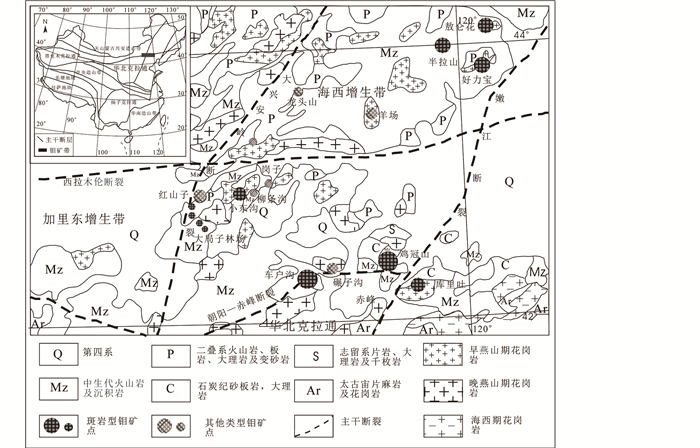
|
图 1 华北克拉通北缘西拉木伦钼矿带地质简图(据曾庆栋等,2009b) Fig. 1 Sketch geological map of Xilamulun Mo-metallogenic belt (after Zeng et al., 2009b) |
车户沟钼铜矿床位于内蒙古自治区赤峰市松山区境内。该矿床于2007年发现,平均品位Cu为0.14%、Mo为0.1%(Zeng et al., 2011a)。估算Cu金属量15535吨,Mo金属量16306吨(核工业二四三大队, 2009①)。前人研究获得黄铜矿Rb-Sr等时线年龄为256±7Ma (Wan et al., 2009),辉钼矿Re-Os加权平均年龄和等时线年龄分别为257.5±2.5Ma (Liu et al., 2010) 和245±5Ma (Zeng et al., 2011b),含矿花岗斑岩锆石SHRIMP U-Pb年龄为245.1±4.4Ma (Zeng et al., 2011b, 2012b),这些年龄变化于257Ma至245Ma之间,对于斑岩成矿系统而言,年龄范围偏大。褚少雄等(2010)和段晓侠等(2010)分别从流体包裹体和氢、氧同位素方面研究了成矿流体的特征,但未能探讨岩浆-热液过渡阶段的流体特征和演化。鉴于上述,作者通过成矿岩体锆石U-Pb年龄和辉钼矿Re-Os年龄测定,确认成矿时间为250Ma左右,成岩成矿作用发生在大陆碰撞构造背景。通过流体包裹体和氢-氧同位素研究,揭示了成矿流体的特征和演化过程,发现并解释了初始流体具有高温、低盐度、富CO2的特征,早期成矿流体具有高温、高盐度、含CO2的特征,提出了矿质沉淀的机制。
① 核工业二四三大队. 2009.内蒙古自治区赤峰市松山区车户沟矿区钼铜矿补充详查报告.内部资料
2 区域地质和矿床地质西拉木伦成矿带位于近东西向的西拉木伦断裂两侧,属华北克拉通与中亚造山带东段的过渡带,南邻华北克拉通,北为显生宙增生造山带(张连昌等,2010)。在西拉木伦断裂以北广泛发育晚古生代浅变质火山-沉积岩系,以南出露志留系浅变质火山-沉积岩系、石炭系浅变质沉积岩系、二叠系火山-沉积岩系、中生代火山-次火山岩盖层(芮宗瑶等,1984);研究区中酸性岩浆岩大量发育,并以燕山期为主,次为海西期及印支期,表明研究区经历了古生代大陆边缘的侧向增生和中生代以来的陆内垂向增生(陈衍景等,2009)。
矿区位于西拉木伦断裂以南,出露地层主要为太古界乌拉山岩群(Arw) 地层,侏罗系满克头鄂博组(J3mk) 和马尼吐组(J3mn) 地层和第四系沉积(Q)(图 2)。岩浆岩主要为车户沟花岗杂岩体,岩性为二长花岗岩、正长花岗岩、正长花岗斑岩和花岗斑岩。正长花岗斑岩分布于矿区南部,花岗斑岩以不规则岩株侵入正长花岗岩和二长花岗岩中(Zeng et al., 2012b)。车户沟钼铜矿床矿化类型主要为斑岩型、隐爆角砾岩型和石英脉型。斑岩型矿化分布于矿区北侧,钼铜矿体受花岗斑岩岩株控制,呈透镜状、似层状和脉状,矿化基本连续,但不均匀。隐爆角砾岩型矿化呈环状断续分布于矿区北部花岗斑岩体中,受隐爆角砾岩筒控制。石英脉型矿化分布于矿区南部泥盆纪花岗岩和二叠纪正长花岗岩体中。
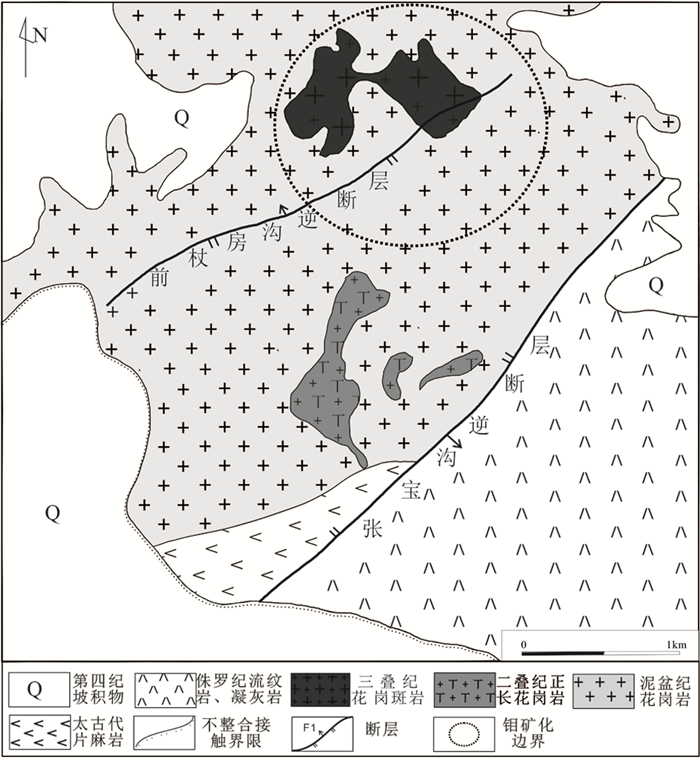
|
图 2 车户沟钼铜矿床地质简图(据Zeng et al., 2012b) Fig. 2 Sketch geological map of Chehugou Mo-Cu deposit (after Zeng et al., 2012b) |
主要围岩蚀变类型包括硅化、绿泥石化、绿帘石化、高岭土化、绢云母化和黄铁绢英岩化,硅化、绢云母化与矿化关系密切(图 3)。围岩蚀变由斑岩钼铜矿体中心向外依次减弱,略显分带性。蚀变类型及强度由内向外可分为:强高岭土化+强黄铁矿化+中弱硅化→中等高岭土化+弱黄铁矿化+弱硅化+弱绿泥石化→弱高岭土化+绿泥石化+绿帘石化+碳酸盐化(褚少雄等,2010)。金属矿物主要为辉钼矿、黄铜矿、黄铁矿,其次为闪锌矿、磁铁矿、针铁矿、赤铁矿,脉石矿物主要为石英、萤石、方解石(图 4)。

|
图 3 车户沟钼铜矿床的矿化和蚀变特征 (a)-隐爆角砾岩,角砾成分为花岗斑岩,胶结物中出现钼矿化;(b)-晚期不含矿石英脉切穿早阶段含辉钼矿石英脉;(c)-正交偏光下的黄铁绢英岩化;(d)-正交偏光下的硅化,石英多为他形粒状;(e)-正交偏光下的碳酸盐岩化;(f)-单偏光下的绿泥石化 Fig. 3 Characteristics of mineralization and alteration in Chehugou Mo-Cu deposit (a)-crypto-explosive breccias, with Mo in the cements; (b)-a quartz-molybdenite vein cut by quartz vein without Mo-mineralization; (c)-beresitization under a crossed polarizer; (d)-silification under a crossed polarizer; (e)-carbonation under a crossed polarizer; (f)-chloritization under a polarizing microscopy |

|
图 4 车户沟钼铜矿床矿石岩相学特征 (a)-正交偏光下的花岗斑岩的石英斑晶;(b)-单偏光下晚阶段含黄铁矿和方解石的石英脉;(c)-反射光下的早阶段辉钼矿与黄铜矿;(d)-反射光下的早阶段叶片状辉钼矿;(e)-反射光下的中阶段的黄铜矿与黄铁矿;(f)-反射光下的中阶段的黄铜与黄铁矿 Fig. 4 Ore petrography of Chehugou Mo-Cu deposit (a)-quartz phenocryst of granite porphyry under a crossed polarizer; (b)-the quartz-calcite-pyrite vein of the late-stage under polarizing microscopy; (c)-the molybdenite and chalcopyrite in the early stage under a reflecting-microscope; (d)-the leaf-shaped molybdenite in the early stage under a reflecting-microscope; (e)-chalcopyrite and pyrite in the middle stage under a reflecting-microscope; (f)-chalcopyrite and pyrite in the middle stage under a reflecting-microscope |
根据脉体穿插关系、矿石组构和矿物组合(图 3、图 4),将矿化过程分为四个阶段:
矿前阶段:矿物组合为石英+磁铁矿。流体包裹体赋存于花岗斑岩的石英斑晶中,石英斑晶边部可见港湾状溶蚀结构。
早阶段:矿物组合为辉钼矿+石英±黄铜矿±黄铁矿。辉钼矿主要呈毛发状、叶片状分布于脉石矿物粒间,部分呈玫瑰花状集合体分布于石英脉壁两侧,黄铁矿多呈自形粒状结构,零星浸染状分布于岩体内。
中阶段:矿物组合为黄铜矿+黄铁矿+石英。黄铁矿呈自形粒状、小团块状与黄铜矿作为共生组合,分布于石英脉壁两侧。黄铜矿呈半自形粒状、小团块状沿黄铁矿晶隙分布,黄铜矿晶粒中可见闪锌矿出溶。
晚阶段:矿物组合为石英+方解石+萤石±黄铁矿,黄铁矿零星分布于石英脉中,方解石则主要呈半自形沿黄铁矿边部分布,可见该阶段的脉体穿插早阶段含辉钼矿石英脉的现象(图 3b)。
3 锆石LA-ICP-MS年代学研究 3.1 样品采集与分析方法用于锆石激光剥蚀熔融等离子质谱(LA-ICP-MS) U-Pb同位素分析的样品为含矿的花岗斑岩(CHG12-12)。锆石分选工作在河北区域地质矿产调查院完成,阴极发光(CL) 图像和锆石U-Pb同位素分析在西北大学大陆动力学国家重点实验室完成。
阴极发光(CL) 分析在场发射环境扫描电子显微镜附属的MonoCL3+系统上进行,锆石ICP-MS定年仪器为带有Shield Torch的Agilient7500a,激光剥蚀系统为美国MicroLas公司生产的Geolas200M,用He作为剥蚀物质的载气,斑束直径为44μm,频率为10Hz,激光能量为90mJ,每个分析点的气体背景采集时间为30s,信号采集时间为40s。U-Pb数据处理采用Glitter (ver4.0) 程序进行,普通铅校正采用Andersen (2002, 2005) 的方法,谐和图及加权平均值的计算采用Ludwig (2003)的Isoplot ver3.0软件进行。
3.2 锆石U-Pb定年结果镜下观察显示,车户沟含矿花岗斑岩中的锆石均为无色透明长柱状-短柱状,粒径约为30~120μm,自形程度较高,CL图像具有明显的岩浆锆石振荡环带(图 5)。
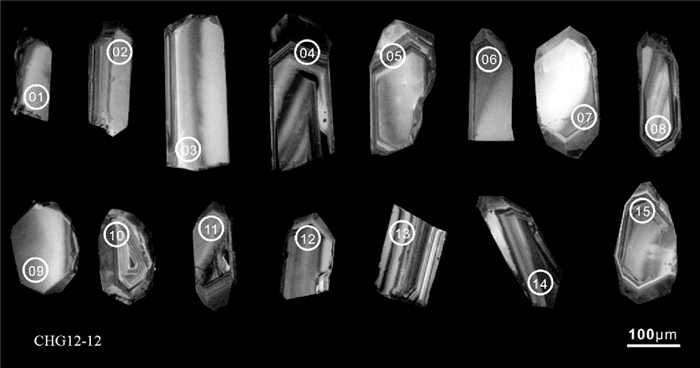
|
图 5 车户沟钼铜矿区花岗斑岩锆石阴极发光图 Fig. 5 Cathodoluminescence images of zircons from granite porphyry in Chehugou Mo-Cu deposit |
车户沟含矿斑岩中15个锆石样品的测试结果见表 1。图 6为锆石数据的谐和曲线,206Pb/238U加权平均值为251.6±3.2Ma (MSWD=5)。
|
|
表 1 车户沟钼铜矿区花岗斑岩U-Pb同位素数据 Table 1 The data of zircon U-Pb isotope for granite porphyry of Chehugou Mo-Cu deposit |
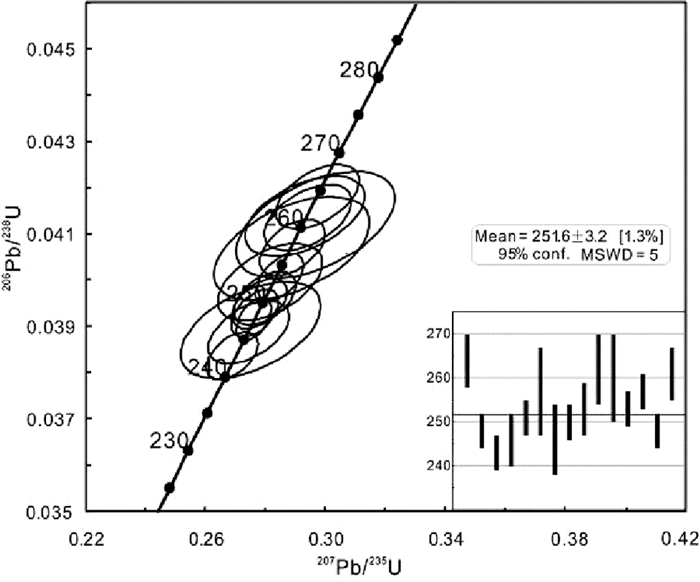
|
图 6 车户沟钼铜矿区花岗斑岩LA-ICP-MS锆石U-Pb谐和年龄图 Fig. 6 The LA-ICP-MS zircon U-Pb concordia diagrams for the granite porphyry of Chehugou Mo-Cu deposit |
9件辉钼矿样品采自车户沟矿床斜井及钻孔岩芯,辉钼矿呈叶片状、网脉状、细脉浸染状分布于含矿花岗斑岩中。首先将样品粉碎至30目左右,进行粗分离,避开与辉钼矿连生的石英等矿物,挑出辉钼矿;之后将辉钼矿粉碎至60~80目,在双目镜下挑选出辉钼矿晶体,使纯度达到99%以上,最后置入玛瑙研钵中粉碎至200目,以增加样品的均匀性,克服失耦现象对准确定年的影响(杜安道等,2007)。
辉钼矿样品Re-Os同位素分析在国家地质实验测试中心Re-Os同位素年代学实验室完成,采用美国TJA公司生产的TJA X-series ICPMS测定同位素比值。对于Re,选择质量数185、187,用185监测Re;对于Os,选择质量数186、187、188、189、190、192,用190监测Os。样品的化学处理流程和质谱测定技术参数详见文献(屈文俊和杜安道,2003;Du et al., 2004)。
4.2 辉钼矿Re-Os定年结果9件辉钼矿Re-Os同位素测试结果见表 2。9件辉钼矿样品的模式年龄介于247.3±3.8Ma~250.7±3.7Ma之间, 等时线年龄为250.2±7.2Ma,MSWD为0.64(图 7)。这一年龄与含矿花岗斑岩的锆石U-Pb年龄一致。
|
|
表 2 车户沟钼铜矿辉钼矿Re-Os同位素数据 Table 2 The data of Re-Os isotope for molybdenite of Chehugou Mo-Cu deposit |
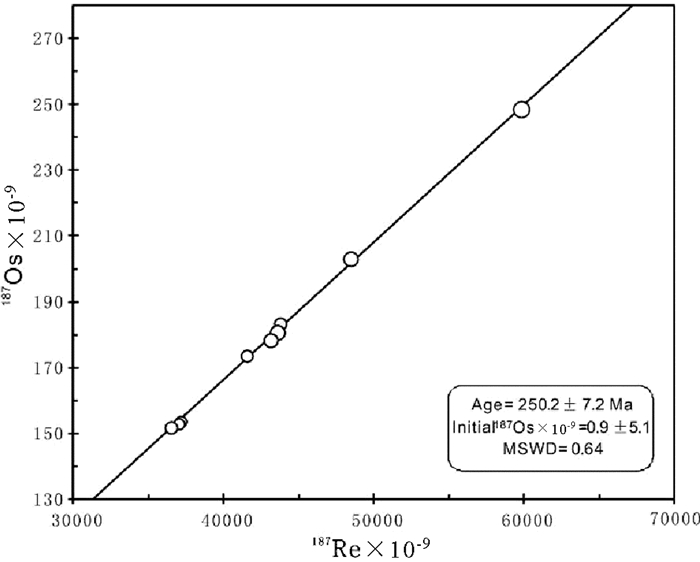
|
图 7 内蒙古车户沟Mo-Cu矿床辉钼矿Re-Os等时线图 Fig. 7 Re-Os isotope isochron for molybdenite of Chehugou Mo-Cu deposit |
对车户沟钼铜矿区不同中段样品切片后进行显微岩相学观察后,选择代表性包裹体片进行激光拉曼显微探针(LRM) 分析及显微测温。
单个包裹体成分激光拉曼测试在北京大学造山带与地壳演化教育部重点实验室进行。仪器为RM-1000型激光拉曼光谱仪,光源为514.5nm氩激光器,激光束斑为2μm,计数时间为10s,每1cm-1(波数) 计数一次,1000~4000cm-1全波段一次取峰,光谱分辨率±2cm-1。
流体包裹体显微测温在北京大学造山带与地壳演化教育部重点实验室进行。使用美国INSTEC HCS622XY型冷热台,温度范围为-196~+600℃,在温度低于100℃时测试精度为±0.1℃,100℃至600℃之间为±1℃。实验过程中分别对石英斑晶和各成矿阶段石英脉中的各类包裹体进行了均一温度和冰点温度的测试,升、降温速率控制在5~10℃/min以内,相变点附近控制在0.5~1℃/min以内。
对中高盐度包裹体(含盐类子晶),其数据处理按照NaCl-H2O体系进行,根据石盐子晶的熔化温度计算盐度(刘斌和沈昆,1999),对于盐不饱和的水溶液包裹体(气液两相包裹体),以最终冰融化温度计算盐度(Bodnar, 1993)。对于含CO2三相包裹体,其数据处理按H2O-NaCl-CO2体系进行,根据CO2水合物(笼合物) 消失温度计算盐度(Collins, 1979)。
5.2 流体包裹体类型含矿斑岩石英斑晶和各阶段的石英脉中均富含流体包裹体(图 8),根据室温下流体包裹体相组成特征、冷冻/加热过程中的相变行为将流体包裹体分为5种类型,即含子晶多相包裹体(S类)、纯气相包裹体(PV类)、富气相水溶液包裹体(V类)、富液相水溶液包裹体(L类)、富CO2三相包裹体(C类)。

|
图 8 车户沟钼铜矿床的流体包裹体显微照片 (a)-石英斑晶中C类包裹体;(b)-早阶段石英中的V类包裹体;(c)-中阶段石英中的S类包裹体;(d)-早阶段石英中的C类包裹体;(e)-早阶段石英中S类包裹体与C类包裹体共生;(f)-早阶段石英中V类、S类包裹体共生,显示出沸腾特征 Fig. 8 Microphotographs of fluid inclusions of Chehugou Mo-Cu deposit (a)-C-type fluid inclusions in quartz phenocryst; (b)-V-type fluid inclusion in the quartz of early stage; (c)-S-type fluid inclusion in the quartz of middle stage; (d)-C-type fluid inclusion in the quartz of early stage; (e)-coexistence of S-and C-types fluid inclusions; (f)-coexistence of S-, V-type fluid inclusions in the early stage, showing a population of fluid inclusions trapped from boiling fluid |
S类包裹体主要存在于早、中阶段石英脉中,呈不规则状或负晶状,大小5~10μm,多数包裹体只含有一个子晶,子晶多为无色透明立方体石盐子晶,个别包裹体除石盐子晶外,还有另一种未知子矿物。
PV类和V类包裹体密切共生,主要存在于早阶段石英脉中,常与S类及L类包裹体共生,两类包裹体主要呈负晶形,少数呈椭球状,长轴长度多集中在8~10μm之间。PV类气液比高于95%,V类包裹体的气液比在50%~95%范围内,室温下颜色较深,激光拉曼显微探针分析表明气相成分为H2O。
L类包裹体分布广泛,斑晶石英和早、中、晚石英脉中均有产出。包裹体形态以负晶形、不规则状为主。由早阶段至晚阶段,此类包裹体的比例和数量有所增加,早阶段部分流体包裹体可见细粒不透明子矿物及半透明的赤铁矿,但由于单颗粒较小,未能得到明显的拉曼数据。
C类包裹体主要存于石英斑晶和早阶段石英脉中,在石英斑晶中分布广泛,大小8~15μm,呈负晶形、纺锤状、不规则状等。早期的石英脉中C类与S类包裹体共生,主要呈负晶和不规则状,长轴长度集中在5~10μm。激光拉曼显微探针分析表明C类包裹体主要由气相CO2、液相CO2及液相H2O组成,未检出其他组分。斑晶中部分C类包裹体只检出CO2成分,未检出H2O的成分,为纯CO2包裹体。
石英斑晶中原生包裹体以L、C类包裹体为主,早阶段发育各类型包裹体,包括V类、S类、C类、L类,这四类包裹体密切共生(图 8e, f),显示沸腾包裹体组合特征,中阶段发育L、S类包裹体,晚阶段只发育L类包裹体。
5.3 包裹体成分激光拉曼显微探针(LRM) 分析激光拉曼显微探针分析显示(图 9),早阶段V类包裹体气相成分呈现H2O峰值特征,部分L类包裹体液相中检出CO32-峰(1065.2cm-1),C类包裹体气相显示CO2峰值特征(1285.6cm-1和1388.2cm-1),同时在矿前阶段的石英斑晶中部分C类包裹体仅显示CO2峰值特征(1284.2cm-1和1388.2cm-1),未检出H2O成分。

|
图 9 车户沟钼铜矿床流体包裹体激光拉曼光谱分析 (a)-V类包裹体气相成分显示H2O的特征峰;(b)-C类包裹体气相成分显示CO2成分的特征峰;(c)-石英斑晶中存在的C类包裹体显示CO2的特征峰;(d)-L类包裹体液相显示CO32-特征峰 Fig. 9 Laser Raman Spectra of fluid inclusions of Chehugou Mo-Cu deposit (a)-H2O-spectrum of the gas phase in V-type fluid inclusions; (b)-CO2-spectrum of gas phase in the C-type fluid inclusions; (c)-CO2-spectrum of C-type fluid inclusions from quartz phenocryst; (d)-CO32--spectrum of liquid phase of L-type inclusions |
由激光拉曼显微探针分析可知,矿前和早阶段流体为H2O-NaCl-CO2体系,中阶段与晚阶段流体为H2O-NaCl体系。
5.4 显微测温结果斑晶石英、含辉钼矿石英脉、含黄铜黄铁矿石英脉、含方解石石英脉的测试结果见于表 3和图 10。
|
|
表 3 车户沟钼铜矿流体包裹体显微测温结果 Table 3 Microthermometric data for fluid inclusions from Chehugou Mo-Cu deposit |
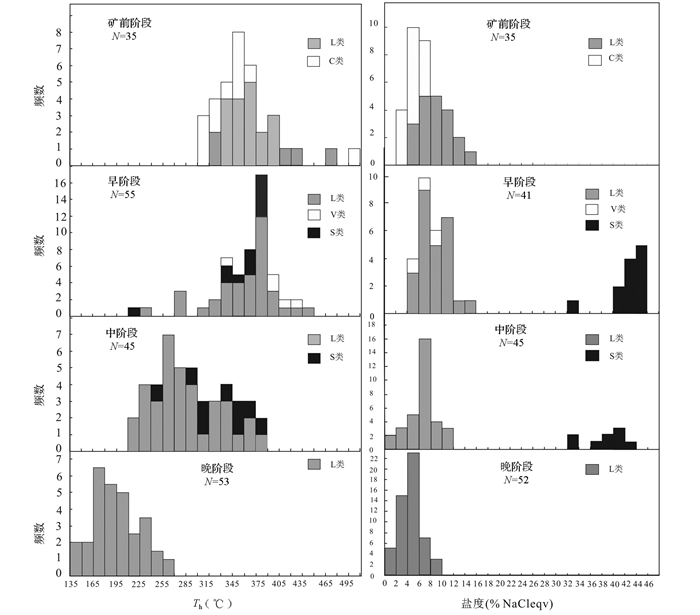
|
图 10 车户沟钼铜矿床流体包裹体均一温度及盐度直方图 Fig. 10 Histograms of homogenization temperatures and salinities of fluid inclusions of Chehugou Mo-Cu deposit |
石英斑晶中原生流体包裹体捕获于岩浆结晶阶段,记录了成矿前岩浆初始流体特征。斑晶中流体包裹体类型主要为L类、C类。L类包裹体均一温度范围为326~483℃,向液相均一,冰点-8.4~-3.4℃,对应的盐度范围为5.6%~12.3% NaCleqv (图 10),密度范围为0.46~0.78g/cm3;C类包裹体时大多向液相CO2部分均一,温度范围为29.0~31.1℃,完全均一温度范围为301~503℃,笼合物消失温度范围为5.9~8.1℃,对应的盐度范围3.7%~7.5% NaCleqv,密度范围0.71~1.01g/cm3。
早阶段是钼沉淀的主要阶段,发育L类、C类、S类及V类包裹体,在薄片中可见同一视域,同一石英颗粒中L类、V类、S类包裹体三者共生(图 8f) 及S类与C类共生(图 8e)。L类包裹体均一温度范围为223~401℃,向液相均一,冰点温度-12.0~-3.2℃,对应的盐度范围为5.3%~16.0% NaCleqv,密度范围为0.61~0.91g/cm3;C类包裹体部分均一温度为30.4℃和31.1℃,完全均一温度为305℃和333℃,笼合物消失温度为6.2℃和4.2℃,对应的盐度为7.1% NaCleqv和10.2% NaCleqv,密度为0.58g/cm3和0.77g/cm3;S类包裹体均一温度范围为210~385℃,大部分为子晶后消失,盐度范围为32.4%~45.8% NaCleqv,流体密度为1.07~1.18g/cm3;V类包裹体均一温度范围为340~423℃,向气相均一,冰点为-6.7~-3.7℃,对应的盐度范围为6.0%~10.1% NaCleqv,流体密度为0.55~0.72g/cm3。
中阶段是铜沉淀的主要阶段,流体包裹体包括L类和S类。L类包裹体均一温度范围为210~391℃,向液相均一,冰点范围-7.9~-1.0℃,对应的盐度范围为1.7%~11.6% NaCleqv,流体密度范围为0.60~0.92g/cm3;S类包裹体均一温度为246~372℃,个别包裹体均一时,子晶先消失,大部分包裹体则是气泡先消失,盐度范围为32.4%~43.8% NaCleqv,流体密度范围为1.05~1.16g/cm3。
晚阶段石英脉中流体包裹体全为L类,均一温度范围为140~257℃,冰点-7.8~-1.4℃,对应的盐度范围为2.4%~11.5% NaCleqv,流体密度为0.82~0.99g/cm3。
6 氢氧同位素分析 6.1 样品采集和分析方法对早、中、晚阶段矿脉中石英单矿物进行了H-O同位素分析。样品清净后破碎至60~80目,在双目镜下挑选出石英矿物颗粒,用盐酸溶液清洗,再用去离子水清洗3~4次,去除石英表面吸附的矿物,最后在60℃恒温箱中将石英样品烘干。测试工作在中国地质科学院矿产资源研究所稳定同位素实验室完成,分析仪器为MAT-253质谱仪,氢同位素测试采用加热爆裂法提取原生包裹体中水,锌法制氢,测试精度为±2‰;氧同位素分析采用BrF5法提取矿物氧(Clayton and Mayeda, 1963),测试精度为±0.2‰。
6.2 测试结果17件石英样品的氢、氧同位素测试结果见表 4,δDH2O值介于-84‰~-105‰之间,δ18Оquartz范围为8.0‰~11.8‰,根据矿物水平衡公式1000lnαquartz-H2O=3.38×106T-2-3.40(Clayton et al., 1972) 进行换算,平衡温度T选取各阶段流体包裹体均一温度的平均值,计算后的δ18ОH2O的范围为-5.1‰~5.7‰。
|
|
表 4 车户沟钼铜矿各阶段石英H-O同位素数据 Table 4 Data of H-O isotope in quartz from different stages in Chehugou Mo-Cu deposit |
结果显示,早阶段H-O同位素范围(δ18OH2O=5.1‰~5.7‰,δDH2O=-91‰~-88‰) 接近岩浆水范围(δ18OH2O为5.5‰~9.5‰,δDH2O为-80‰~-50‰,Taylor, 1968),反映早阶段成矿流体主要为岩浆热液。中阶段δ18OH2O和δDH2O范围分别为-1.3‰~4.2‰和-105‰~-84‰,晚阶段δ18OH2O和δDH2O范围分别为-5.1‰~-1.9‰和-102‰~-84‰,中、晚阶段H-O同位素投影点向大气降水区域漂移,反映大气降水的加入(图 11)。
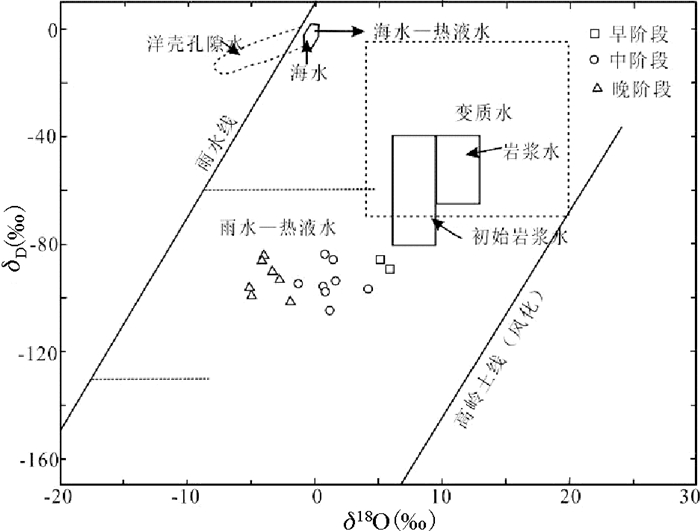
|
图 11 车户沟钼铜矿成矿流体H-O同位素图解(底图据Taylor, 1979) Fig. 11 H-O isotope diagram of ore fluid of Chehugou deposit (after Taylor, 1979) |
尽管对古亚洲洋闭合时限尚存在不同认识,但大部分学者认为兴蒙造山带部分最终的闭合发生在晚二叠-早三叠时期(Dobretsov et al., 1995; Sengör and Natal’in, 1996; Chen et al., 2000, 2009; Zhang et al., 2009b; Wu et al., 2011c)。Zhang et al.(2009b)以及Chen et al.(2000, 2009) 在华北北缘和兴蒙造山带内分别发现了岛弧岩浆以及后碰撞岩浆作用,这些岛弧岩浆侵位年龄均老于270Ma,而后碰撞岩浆活动则发生在三叠纪(均晚于250Ma),表明最终的闭合作用很可能发生在270~250Ma之间。本文获得的车户沟矿床成矿地质体花岗斑岩的成岩年龄为250Ma左右,应当略晚于最终闭合年龄,是碰撞环境下的成岩作用。Zeng et al.(2012b)对车户沟矿区的系列岩体进行了详细的地球化学研究,这些结果显示,与成矿作用相关的花岗岩体来源于古老下地壳,同时伴有少量地幔组分的混入,表明成矿岩体形成于陆内碰撞过程挤压-伸展转变期的早期。在陆内碰撞过程的挤压-伸展的转变期,造山带处于减压增温的特殊构造体制中,将发生最强烈的岩浆和成矿作用(陈衍景和富士谷,1992;陈衍景等,1995: Chen et al., 2004, 2005, 2012),车户沟钼铜矿床就形成于此背景。
7.2 初始流体特征车户沟钼铜矿的成矿初始流体是与斑岩体相关的岩浆热液,具有高温(最高可达500℃以上)、低盐度( < 12.2% NaCleqv)、富CO2等特征。Cl从岩浆中的出溶压力要低于CO2和H2O (Giggenbach, 1997)。因此,含CO2岩浆在演化过程中会在深部形成富CO2低盐度流体,而在浅部形成高盐度流体(Shinohara and Kazahaya, 1995)。车户沟初始流体高温、低盐度、富CO2的特征反映流体出溶深度较深。相似的低盐度富CO2包裹体组合在国内外矿床中也有报道(John, 1989; Cline and Bodnar, 1991; Redmond, 2004; Rusk et al., 2007, 2008; Li et al., 2012b; Yang et al., 2012)。Rusk et al.(2008)对Butte斑岩Cu-Mo矿的压力估算值在200~250MPa之间,Yang et al.(2012)对南泥湖斑岩Mo-W的压力估算高达270MPa,表明高温低盐度富CO2是较深斑岩成矿环境的初始流体特征。在深侵位的岩浆系统中,流体通常以“第二类沸腾”出溶,岩浆结晶分异程度高,Mo作为不相容元素(Dcrystal/melt为0.02),将在残余岩浆中富集,同时Mo在流体中的高分配系数(Dfluid/melt为2.5) 使得Mo在流体中进一步富集,从残余岩浆中出溶的流体将富Mo (Robb, 2005)。这可能就是造成车户沟Mo-Cu矿以Mo矿化为主的主要原因。
陈衍景等(2007)提出大陆碰撞造山带斑岩矿床成矿流体中含有CO2,其CO2含量明显高于岩浆弧环境下的斑岩型矿床。事实上,我国大陆内部的岩浆热液矿床成矿流体普遍富含CO2(陈衍景和李诺, 2009),尤其以大别山汤家坪、千鹅冲等斑岩钼矿床(Chen and Wang, 2011; Yang et al., 2013) 以及秦岭地区的鱼池岭(Li et al., 2012b) 和南泥湖(Yang et al., 2012) 等斑岩钼矿床为典型。本文所揭示的车户沟矿床成矿流体也以富CO2为特点,显示其为大陆碰撞体制形成的铜钼成矿系统。
7.3 流体演化与矿质沉淀早阶段是钼沉淀的主要阶段。石英脉中存在富液相(L类)、富气相(V类)、含CO2三相(C类) 以及含子晶多相(S类) 包裹体共生的现象,包裹体显微测温显示上述四类包裹体均一温度相近,均一方式多样,且盐度悬殊(图 12),为典型的沸腾包裹体组合,反映成矿早阶段流体不混溶作用(Ramboz, 1982),这类沸腾包裹体组合在很多斑岩型铜钼矿床中均有报道(李诺等,2007b;舒启海等,2009;Yang et al., 2012, 2013),表明沸腾作用在斑岩型矿床中普遍存在。从矿前阶段至早阶段流体由单一低盐度分异为中高盐度与低盐度两个端元,CO2等挥发性气体的含量也有明显降低,温度无明显变化,显示出钼的沉淀可能与减压沸腾作用有关(Zeng et al., 2011a)。
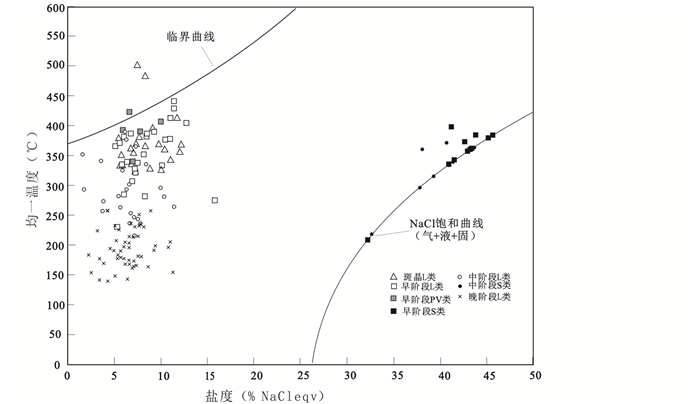
|
图 12 流体包裹体均一温度-盐度分布图(底图据Bodnar,1983) Fig. 12 Homogenization temperatures vs salinities of fluid inclusions of Chehugou Mo-Cu deposit (after Bodnar, 1983) |
中阶段的沉淀金属主要为铜,这一阶段的流体相对于早阶段,盐度无明显变化,温度有所降低,C类和V类包裹体消失,未见沸腾包裹体组合,H-O同位素与早阶段相比,向大气降水区域漂移(图 11),表明流体系统趋于开放,大气降水混入,流体温度降低,CO2等挥发性气体进一步逸失,导致黄铜矿等沉淀析出。
晚阶段流体温度进一步降低,S类包裹体消失,表明大气降水的大量混入导致晚期的流体盐度降低,这与氢氧同位素的特征一致(图 11)。
随着斑岩体冷却收缩,流体从斑岩体内部向上运移,富集在斑岩体顶部,强大的流体压力引发隐爆角砾岩筒以及周边张性裂隙的形成,致使压力突然降低,导致早阶段流体发生不混溶作用,流体分异成高盐度和富气低盐度端元,同时CO2等挥发分急剧逃逸,导致辉钼矿和少量黄铁矿的沉淀,减压沸腾是早期辉钼矿沉淀的主要机制。至中阶段,流体沸腾作用不再明显,随着流体系统趋于开放,大气降水开始混入,温度降低,CO2等挥发性气体进一步逸失导致黄铜矿等发生沉淀。至晚阶段,大气降水大量混入,流体温度下降,盐度降低,只有方解石及少量黄铁矿的沉淀。
8 结论(1) 车户沟钼铜矿床含矿花岗斑岩LA-ICP-MS测试给出的锆石U-Pb同位素年龄为251.6±3.2Ma,辉钼矿Re-Os等时线年龄为250.2±7.2Ma,表明车户沟钼铜矿床是早三叠世中酸性岩浆活动所形成的斑岩型金属矿床,是古亚洲洋闭合后碰撞造山作用下产物,成岩成矿发生在碰撞过程中伸展-挤压转变期。
(2) 车户沟钼铜矿床初始成矿流体为岩浆流体,沸腾作用是钼沉淀富集的主因;成矿中阶段大气降水的混入则导致黄铜矿的大量沉淀。
致谢 论文的野外工作得到赤峰国维矿业有限公司的大力支持;实验室工作得到北京大学任景秋、贾秋月等工程师和西北大学戴梦宁老师的帮助;陈衍景教授、张连昌研究员及另一位匿名审稿人审阅了本文,并提出了宝贵的修改意见;在此一并致谢。| [] | Andersen T. 2002. Correction of common lead in U-Pb analyses that do not report 204Pb. Chemical Geology, 192(1-2): 59–79. DOI:10.1016/S0009-2541(02)00195-X |
| [] | Andersen T. 2005. Detrital zircons as tracers of sedimentary provenance: Limiting conditions from statistics and numerical simulation. Chemical Geology, 216(3-4): 249–270. DOI:10.1016/j.chemgeo.2004.11.013 |
| [] | Bodnar RJ. 1983. A method of calculating fluid inclusion volumes based on vapor bubble diameters and PVTX properties of inclusion fluids. Economic Geology, 78(3): 535–542. DOI:10.2113/gsecongeo.78.3.535 |
| [] | Bodnar RJ. 1993. Revised equation and table for determining the freezing point depression of H2O-NaCl solutions. Geochimica et Cosmochimica Acta, 57(3): 683–684. DOI:10.1016/0016-7037(93)90378-A |
| [] | Chen B, Jahn BM, Wilde S, Xu B. 2000. Two contrasting Paleozoic magmatic belts in northern Inner Mongolia, China: Petrogenesis and tectonic implications. Tectonophysics, 328(1-2): 157–182. DOI:10.1016/S0040-1951(00)00182-7 |
| [] | Chen B, Jahn BM, Tian W. 2009. Evolution of the Solonker suture zone: Constraints from zircon U-Pb ages, Hf isotopic ratios and whole-rock Nd-Sr isotope compositions of subduction and collision-related magmas and forearc sediments. Journal of Asia Earth Science, 34(3): 245–257. DOI:10.1016/j.jseaes.2008.05.007 |
| [] | Chen YJ, Fu SG. 1992. Mineralization of Gold Deposits in West Henan. Beijing: Earthquake Publishing House: 180-219. |
| [] | Chen YJ, Yu F, Wei QY, Gao XL, Chang ZS, Song XY. 1995. Significance and current situation of study on fluidization and mineralization under intracontinental collision regime. Advance in Earth Sciences, 10(4): 318–322. |
| [] | Chen YJ, Pirajno F, Sui YH. 2004. Isotope geochemistry of the Tieluping silver-lead deposit, Henan, China: A case study of orogenic silver-dominated deposits and related tectonic setting. Mineralium Deposita, 39(5-6): 560–575. DOI:10.1007/s00126-004-0429-9 |
| [] | Chen YJ, Pirajno F, Qi JP. 2005. Origin of gold metallogeny and sources of ore-forming fluids, Jiaodong province, eastern China. International Geology Review, 47(5): 530–549. DOI:10.2747/0020-6814.47.5.530 |
| [] | Chen YJ. 2006. Orogenic-type deposits and their metallogenic model and exploration potential. Geology in China, 33(6): 1181–1192. |
| [] | Chen YJ, Chen HY, Zaw K, Pirajno F, Zhang ZJ. 2007. Geodynamic settings and tectonic model of skarn gold deposits in China: An overview. Ore Geology Reviews, 31(1-4): 139–169. DOI:10.1016/j.oregeorev.2005.01.001 |
| [] | Chen YJ, Ni P, Fan HR, Pirajno F, Lai Y, Su WC, Zhang H. 2007. Diagnostic fluid inclusions of different types hydrothermal gold deposits. Acta Petrologica Sinica, 23(9): 2085–2108. |
| [] | Chen YJ, Li N. 2009. Nature of ore-fluid of intracontinental intrusion-related hypothermal deposits and its difference from those in island arcs. Acta Petrologica Sinica, 25(10): 2477–2508. |
| [] | Chen YJ, Zhai MG, Jiang SY. 2009. Significant achievements and open issues in study of orogenesis and metallogenesis surrounding the North China continent. Acta Petrologica Sinica, 25(11): 2695–2726. |
| [] | Chen YJ, Wang Y. 2011. Fluid inclusion study of the Tangjiaping Mo deposit, Dabie Shan, Henan Province: Implications for the nature of the porphyry systems of post-collisional tectonic settings. International Geology Review, 53(5-6): 635–655. DOI:10.1080/00206811003783422 |
| [] | Chen YJ, Pirajno F, Wu G, Qi JP, Xiong XL. 2012. Epithermal deposits in North Xinjiang, NW China. International Journal of Earth Sciences, 101(4): 889–917. DOI:10.1007/s00531-011-0689-4 |
| [] | Chen YJ, Zhang C, Li N, Yang YF, Deng K. 2012. Geology of the Mo deposits in Northeast China. Journal of Jilin University (Earth Science), 42(5): 1223–1268. |
| [] | Chen ZG, Zhang LC, Wu HY, Wan B, Zeng QD. 2008. Geochemistry study and tectonic background of A style host granite in Nianzigou molybdenum deposit in Xilamulun molybdenum deposit in ilamulun molybdenum metallogenic belt, Inner Mongolia. Acta Petrologica Sinica, 24(4): 879–889. |
| [] | Chu SX, Zeng QD, Liu JM, Zhang WQ, Zhang ZL, Zhang S, Wang ZC. 2010. Characteristics and its geological significance of fluid inclusions in Chehugou porphyry Mo-Cu deposit, Xilamulun molybdenum metallogenic belt. Acta Petrologica Sinica, 26(8): 2465–2481. |
| [] | Clayton RN, Mayeda TK. 1963. The use of bromine pentafluoride in the extraction of oxygen from oxides and silicates for isotopic analysis. Geochimica et Cosmochimica Acta, 27(1): 43–52. DOI:10.1016/0016-7037(63)90071-1 |
| [] | Clayton RN, O'Neil JR, Mayeda TK. 1972. Oxygen isotope exchange between quartz and water. Journal of Geophysical Research, 77(17): 3057–3067. DOI:10.1029/JB077i017p03057 |
| [] | Cline JS, Bodnar RJ. 1991. Can economic porphyry copper mineralization be generated by a typical calc-alkaline melt?. Journal of Geophysical Research, 96(B5): 8113–8126. DOI:10.1029/91JB00053 |
| [] | Collins PLF. 1979. Gas hydrates in CO2-bearing fluid inclusions and the use of freezing data for estimation of salinity. Economic Geology, 74(6): 1435–1444. DOI:10.2113/gsecongeo.74.6.1435 |
| [] | Dobretsov NL, Berzin NA, Buslov M. 1995. Opening and tectonic evolution of the Paleo-Asian Ocean. International Geology Reviews, 37(4): 335–360. DOI:10.1080/00206819509465407 |
| [] | Du AD, Wu SQ, Sun DZ, Wang SX, Qu WJ, Richard M, Holly S, John M, Dmitry M. 2004. Preparation and certification of Re-Os dating reference materials: Molybdenites HLP and JDC. Geostandards and Geoanalytical Research, 28(1): 41–52. DOI:10.1111/ggr.2004.28.issue-1 |
| [] | Du AD, Qu WJ, Wang DH, Li HM, Feng CY, Liu H, Ren J, Zeng FG. 2007. Subgrain-size decoupling of Re and 187Os within molybdenite. Mineral Deposits, 26(5): 572–580. |
| [] | Duan XX, Zeng QD, Chu SX. 2010. Characteristics of fluid in Chehugou porphyry Mo-Cu Deposit. Mineral Deposits, 29(1): 573–574. |
| [] | Giggenbach WF. 1997. The origin and evolution of fluids in magmatic-hydrothermal systems. In: Barnes HL (ed.). Geochemistry of Hydrothermal Ore Deposits. New York: John Wiley and Sons Inc.: 737-796. |
| [] | Hou ZQ, Pan XF, Yang ZM, Qu XM. 2007. Porphyry Cu-(Mo) deposits no related to oceanic-Slab subduction: Examples from Chinese porphyry deposits in continental settings. Geoscience, 21(2): 333–348. |
| [] | John DA. 1989. Geologic setting, depths of emplacement, and regional distribution of fluid inclusions in intrusions of the central Wasatch Mountains. Economic Geology, 84(2): 386–409. DOI:10.2113/gsecongeo.84.2.386 |
| [] | Li N, Chen YJ, Zhang H, Zhao TP, Wang Y, Deng XH, Ni ZY. 2007a. Molybdenum deposits in East Qinling. Earth Science Frontiers, 14(5): 187–196. |
| [] | Li N, Chen YJ, Lai Y, Li WB. 2007b. Fluid inclusion study of the Wunugetushan porphyry Cu-Mo deposit, Inner Mongolia. Acta Petrologica Sinica, 23(9): 2177–2188. |
| [] | Li N, Chen YJ, Pirajno F and Ni ZY. 2012a. Timing of the Yuchiling giant porphyry Mo system and implication for ore genesis. Mineralium Deposita, doi:10.1007/s00126-012-0441-4 |
| [] | Li N, Ulrich T, Chen YJ, Thompson TB, Peace V, Pirajno F. 2012b. Fluid evolution of the Yuchiling porphyry Mo deposit, East Qinling, China. Ore Geology Reviews, 48: 442–459. DOI:10.1016/j.oregeorev.2012.06.002 |
| [] | Liu B, Shen K. 1999. Thermodynamics of Fliud Inclusion. Beijing: Geological Publishing House: 49-52. |
| [] | Liu JM, Zhao Y, Sun YL, Li DP, Liu J, Chen BL, Zhang SH, Sun WD. 2010. Recognition of the latest Permian to Early Triassic Cu-Mo mineralization on the northern margin of the North China block and its geological significance. Gondwana Research, 17(1): 125–134. DOI:10.1016/j.gr.2009.07.007 |
| [] | Ludwig KR. 2003. Isoplot3.0: A geochronological toolkit for Micro-soft Excel. Berkeley Geochronology Center, Special Publication(4): 1–70. |
| [] | Mitchell AHG. 1973. Metallogenic belts and angle of dip of Benioff zones. Nature, 245: 49–52. |
| [] | Qu WJ, Du AD. 2003. Highly precise Re-Os dating of Molybdenite by ICP-MS with carius tube sample digestion. Rock and Mineral Analysis, 22(4): 254–257. |
| [] | Ramboz C, Pichavant M, Weisbrod A. 1982. Fluid immiscibility in natural processes-use and misuse of fluid inclusion dataⅡ: Interpretation of fluid inclusion data in terms of fluid immiscibility. Chemical Geology, 37(1-2): 29–48. DOI:10.1016/0009-2541(82)90065-1 |
| [] | Redmond PB, Einaudi MT, Inan EE, Landtwing MR, Heinrich CA. 2004. Copper deposition by fluid cooling in intrusion-centered systems: New insights from the Bingham porphyry ore deposit, Utah. Geology, 32(3): 217–220. DOI:10.1130/G19986.1 |
| [] | Robb L. 2005. Introduction to Ore-Forming Processes. England: Blackwell Publishing: 93-107. |
| [] | Rui ZY, Huang CK, Qi GM, Xu J, Zhang HT. 1984. Porphyry Copper (Molybdenum) Deposits of China. Beijing: Geological Publishing House: 1-350. |
| [] | Rusk BG, Hofstra AH, Emsbo P, Hunt AG, Landis GP, Rye RO. 2007. Origin and compositions of fluids that form porphyry copper (Au-Mo) deposits. Geological Society of America Abstracts with Programs, 39(6): 608. |
| [] | Rusk BG, Reed MH, Dilles JH. 2008. Fluid inclusion evidence for magmatic-hydrothermal fluid evolution in the porphyry copper-molybdenum deposit at Butte, Montana. Economic Geology, 103(2): 307–334. DOI:10.2113/gsecongeo.103.2.307 |
| [] | Sengör AMC, Natal'in BA. 1996. Paleoptectonics of Asia: Frangments of synthesis. In: Yin A and Harrison TM (eds.). The Tectonic Evolution of Asia. Cambridge: Cambridge University Press: 1-640. |
| [] | Shinohara H, Kazahaya K. 1995. Degassing processes related to magma chamber crystallization. In: Thompson JFH (ed.). Magmas, Fluids and Ore Deposits. Mineralogical Association of Canada Short Course Series, 23: 47–70. |
| [] | Shu QH, Jiang L, Lai Y, Lu YH. 2009. Geochronology and fluid inclusion study of the Aolunhua porphyry Cu-Mo deposit in Arhorqin area, Inner Mongolia. Acta Petrologica Sinica, 25(10): 2601–2614. |
| [] | Sillitoe RH. 1972. A plate tectonic model for the origin of porphyry copper deposits. Economic Geology, 67(2): 184–197. DOI:10.2113/gsecongeo.67.2.184 |
| [] | Sillitoe RH and Perella J. 2005. Andean copper province: Tectono-magmatic settings, deposit types, metallogeny, exploration and discovery. In: Hedenquist JW, Thompson JFH, Goldfarb RJ and Richards JP (eds.). Economic Geology 100th Anniversary, 845-890 |
| [] | Taylor HP. 1968. The oxygen isotope geochemistry of igneous rocks. Conrtibutions to Mineralogy and Petrology, 19(1): 1–17. DOI:10.1007/BF00371729 |
| [] | Taylor HP. 1979. Oxygen and hydrogen isotope relationships in hydrothermal mineral deposit. In: Barnes HL (ed.). Geochemistry of Hydrothermal Ore Deposit. New York: Wiley, 236-277 |
| [] | Wan B, Ernst H, Zhang LC, Alexander R, Chen ZG, Wu HY, Chen FK. 2009. Rb-Sr geochronology of chalcopyrite from the Chehugou porphyry Mo-Cu deposit (Northeast China) and geochemical constraints on the origin of hosting granites. Economic Geology, 104(3): 351–363. DOI:10.2113/gsecongeo.104.3.351 |
| [] | Wu FY, Sun DY, Ge WC, Zhang YB, Grant ML, Wilde SA, Jahn BM. 2011c. Geochronology of the phanerozoic granitoids in northeastern China. Journal of Asian Earth Sciences, 41(1): 1–30. DOI:10.1016/j.jseaes.2010.11.014 |
| [] | Wu HY, Zhang LC, Chen ZG, Wan B. 2008. Geochemistries, tectonic setting and mineralization potentiality of the ore-bearing monzogranite in the Kulitu molybdenum (copper) deposit of Xar moron metallogetic belt, Inner Mongolia. Acta Petrologica Sinica, 24(4): 867–878. |
| [] | Wu HY, Zhang LC, Wan B, Chen ZG, Xiang P, Pirajno F, Du AD, Qu WJ. 2011a. Re-Os and 40Ar/39Ar ages of the Jiguanshan porphyry Mo deposit, Xilamulun metallogenic belt, NE China, and constraints on mineralization events. Mineralium Deposita, 46(2): 171–185. DOI:10.1007/s00126-010-0320-9 |
| [] | Wu HY, Zhang LC, Wan B, Chen ZG, Zhang XJ, Xiang P. 2011b. Geochronological and geochemical constraints on Aolunhua porphyry Mo-Cu deposit, Northeast China, and its tectonic significance. Ore Geology Reviews, 43(1): 78–91. DOI:10.1016/j.oregeorev.2011.07.007 |
| [] | Yan C, Sun Y, Lai Y, Ma XH. 2011. LA-ICP-MS zircon U-Pb and molybdenite Re-Os isotope ages and metallogenic geodynamic setting of Banlashan Mo deposit, Inner Mongolia. Mineral Deposits, 30(4): 616–634. |
| [] | Yang YF, Li N, Chen YJ. 2012. Fluid inclusion study of the Nannihu giant porphyry Mo-W deposit, Henan Province, China: Implications for the nature of porphyry ore-fluid systems formed in a continental collision setting. Ore Geology Reviews, 46: 83–94. DOI:10.1016/j.oregeorev.2012.02.003 |
| [] | Yang YF, Chen YJ, Li N, Mi M, Xu YL, Li FL, Wan SQ. 2013. Fluid inclusion and isotope geochemistry of the Qian'echong giant porphyry Mo deposit, Dabie Shan, China: A case of NaCl-poor, CO2-rich fluid systems. Journal of Geochemical Exploration, 124: 1–13. DOI:10.1016/j.gexplo.2012.06.019 |
| [] | Zeng QD, Liu JM, Zhang ZL, Chen WJ, Qin F, Zhang RB, Yu WB, Zhang XH, Zhai MG. 2009a. Mineralizing types, geological characteristics and geodynamic background of molybdenum deposits in Xilamulun molybdenum polymetal metallogenic belt on northern margin of North China Craton. Acta Petrologica Sinica, 25(5): 1225–1238. |
| [] | Zeng QD, Liu JM, Zhang ZL, Qin F, Chen WJ, Zhang RB, Yu CM, Ye J. 2009b. Ore-forming time of the Jiguanshan porphyry molybdenum deposit, northern margin of NorthChina Craton and the Indosinian mineralization. Acta Petrologica Sinica, 25(2): 393–398. |
| [] | Zeng QD, Liu JM, Zhang ZL. 2010. Re-Os geochronology of porphyry molybdenum deposit in south segment of Da Hinggan Mountains, northeastern China. Journal of Earth Sciences, 21(4): 390–401. |
| [] | Zeng QD, Liu JM, Zhang ZL, Zhang WQ, Chu SX, Zhang S, Wang ZC, Duan XX. 2011a. Geology, fluid inclusion, and sulfur isotope studies of the Chehugou porphyry molybdenum-copper deposit, Xilamulun metallogenic belt, NE China. Resource Geology, 61(3): 241–258. DOI:10.1111/rge.2011.61.issue-3 |
| [] | Zeng QD, Liu JM, Zhang ZL, Chen WJ, Zhang WQ. 2011b. Geology and geochronology of the Xilamulun molybdenum metallogenic belt in eastern Inner Mongolia, China. International Journal of Earth Sciences, 100(8): 1791–1809. DOI:10.1007/s00531-010-0617-z |
| [] | Zeng QD, Liu JM, Chu SX, Fu GL, Yu WB, Li ZM, Gao YY, Li YJ, Sun Yan, Zhou LL, Duan XX, Zhang S, Wang YJ. 2011. Mesozoic granitic magmatic and molybdenum ore-forming processes in the Xilamulun metallogenic belt. Journal of Jilin University (Earth Science Edition), 41(6): 1705–1714. |
| [] | Zeng QD, Liu JM, Chu SX, Wang YB, Sun Y, Duan XX, Zhou LL. 2012a. Mesozoic molybdenum deposits in the East Xingmeng orogenic belt, northeast China: Characteristics and tectonic setting. International Geology Review, 54(16): 1843–1869. DOI:10.1080/00206814.2012.677498 |
| [] | Zeng QD, Yang JH, Liu JM, Chu SX, Duan XX, Zhang ZL, Zhang WQ, Zhang S. 2012b. Genesis of the Chehugou Mo-bearing granitic complex on the northern margin of the North China Craton: Geochemistry, zircon U-Pb age and Sr-Nd-Pb isotopes. Geological Magazine, 149(5): 753–767. DOI:10.1017/S0016756811000987 |
| [] | Zhang LC, Wu HY, Wan B, Chen ZG. 2009a. Ages and geodynamic settings of Xilamulun Mo-Cu metallogenic belt in northern part of the North China Craton. Gondwana Research, 16(2): 243–254. DOI:10.1016/j.gr.2009.04.005 |
| [] | Zhang LC, Wu HY, Xiang P, Zhang XJ, Chen ZG, Wan B. 2010. Ore-forming processes and mineralization of complex tectonic system during the Mesozoic: A case from Xilamulun Mo-Cu metallogenic belt. Acta Petrologica Sinica, 26(5): 1351–1362. |
| [] | Zhang SH, Zhao Y, Kroner A, Liu XM, Xie LW, Chen FK. 2009b. Early Permian plutons from the northern North China Block: Constraints on continental arc evolution and convergent margin magmatism related to the Central Asian Orogenic Belt. International Journal of Earth Sciences, 98(6): 1441–1467. DOI:10.1007/s00531-008-0368-2 |
| [] | 陈衍景, 富士谷. 1992. 豫西金矿成矿规律. 北京: 地震出版社: 166-225. |
| [] | 陈衍景, 于方, 魏绮英, 高秀丽, 常兆山, 宋新宇. 1995. 陆内碰撞体制流体作用及成矿作用研究的意义和现状. 地球科学进展, 10(4): 318–322. |
| [] | 陈衍景. 2006. 造山型矿床、成矿模式及找矿潜力. 中国地质, 33(6): 1181–1192. |
| [] | 陈衍景, 倪陪, 范宏瑞, PirajnoF, 赖勇, 苏文超, 张辉. 2007. 不同类型热液金矿系统的流体包裹体特征. 岩石学报, 23(9): 2085–2108. |
| [] | 陈衍景, 李诺. 2009. 大陆内部浆控高温热液矿床成矿流体性质及其与岛弧区同类矿床的差异. 岩石学报, 25(10): 2477–2508. |
| [] | 陈衍景, 翟明国, 蒋少涌. 2009. 华北大陆边缘造山过程与成矿研究的重要进展和问题. 岩石学报, 25(11): 2695–2726. |
| [] | 陈衍景, 张成, 李诺, 杨永飞, 邓轲. 2012. 中国东北钼矿床地质. 吉林大学学报(地球科学版), 42(5): 1223–1268. |
| [] | 陈志广, 张连昌, 吴华英, 万博, 曾庆栋. 2008. 内蒙古西拉木伦成矿带碾子沟钼矿区A型花岗岩地球化学和构造背景. 岩石学报, 24(4): 879–889. |
| [] | 褚少雄, 曾庆栋, 刘建明, 张伟庆, 张作伦, 张松, 汪在聪. 2010. 西拉沐伦钼矿带车户沟斑岩型钼-铜矿床成矿流体特征及其地质意义. 岩石学报, 26(8): 2465–2481. |
| [] | 杜安道, 屈文俊, 王登红, 李厚民, 丰成友, 刘华, 任静, 曾法刚. 2007. 辉钼矿亚晶粒范围内Re和187Os的失耦现象. 矿床地质, 26(5): 572–580. |
| [] | 段晓侠, 曾庆栋, 褚少雄. 2010. 车户沟斑岩钼(铜) 矿成矿流体特征. 矿床地质, 29(1): 573–574. |
| [] | 侯增谦, 潘小菲, 杨志明, 曲晓明. 2007. 初论大陆环境斑岩铜矿. 现代地质, 21(2): 333–348. |
| [] | 李诺, 陈衍景, 张辉, 赵太平, 王运, 邓小华, 倪智勇. 2007a. 东秦岭斑岩钼矿带的地质特征和成矿构造背景. 地学前缘, 14(5): 187–196. |
| [] | 李诺, 陈衍景, 赖勇, 李文博. 2007b. 内蒙古乌奴格吐山斑岩铜钼矿床流体包裹体研究. 岩石学报, 23(9): 2178–2187. |
| [] | 刘斌, 沈昆. 1999. 流体包裹体热力学. 北京: 地质出版社: 49-52. |
| [] | 屈文俊, 杜安道. 2003. 高温密闭溶样电感耦合等离子体质谱准确测定辉钼矿铼-锇地质年龄. 岩矿测试, 22(4): 254–257. |
| [] | 芮宗瑶, 黄崇轲, 齐国明, 徐珏, 张洪涛. 1984. 中国斑岩铜(钼) 矿床. 北京: 地质出版社: 1-350. |
| [] | 舒启海, 蒋林, 赖勇, 鲁颖淮. 2009. 内蒙古阿鲁科尔沁旗敖仑花斑岩铜钼矿床成矿时代和流体包裹体研究. 岩石学报, 25(10): 2601–2614. |
| [] | 吴华英, 张连昌, 陈志广, 万博. 2008. 内蒙古西拉木伦成矿带库里吐钼(铜) 矿区二长花岗岩地球化学、构造环境和含矿性分析. 岩石学报, 24(4): 867–878. |
| [] | 闫聪, 孙艺, 赖勇, 马星华. 2011. 内蒙古半拉山钼矿LA-ICP-MS锆石U-Pb与辉钼矿Re-Os年龄及其成矿动力学背景. 矿床地质, 30(4): 617–631. |
| [] | 曾庆栋, 刘建明, 张作伦, 陈伟军, 覃锋, 张瑞斌, 于文斌, 张晓晖, 翟明国. 2009a. 华北克拉通北缘西拉沐沦钼多金属成矿带钼矿化类型、特征及地球动力学背景. 岩石学报, 25(5): 1225–1238. |
| [] | 曾庆栋, 刘建明, 张作伦, 覃锋, 陈伟军, 张瑞斌, 于昌明, 叶杰. 2009b. 华北克拉通北缘鸡冠山斑岩钼矿床成矿年代及印支期成矿事件. 岩石学报, 25(2): 393–398. |
| [] | 曾庆栋, 刘建明, 褚少雄, 付国立, 于文斌, 李泽明, 高玉友, 李元九, 孙燕, 周伶俐, 段晓侠, 张松, 王永彬. 2011. 西拉沐伦成矿带中生带花岗岩浆活动和钼成矿作用. 吉林大学学学报(地球科学版), 41(6): 1705–1714. |
| [] | 张连昌, 吴华英, 相鹏, 张晓静, 陈志广, 万博. 2010. 中生代复杂构造体系的成矿过程与成矿作用--以华北大陆北缘西拉木伦钼铜多金属成矿带为例. 岩石学报, 26(5): 1351–1362. |
 2013, Vol. 29
2013, Vol. 29


